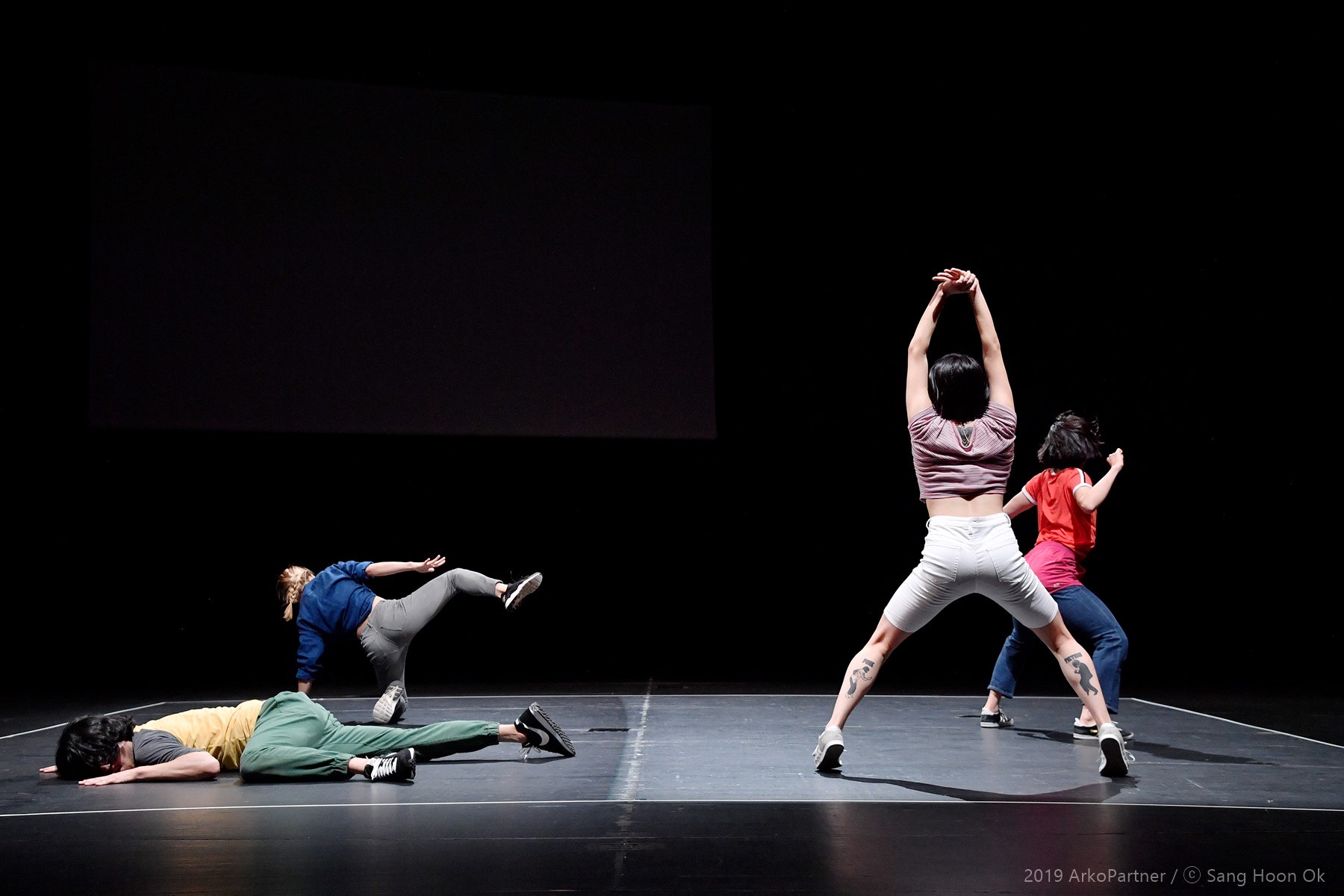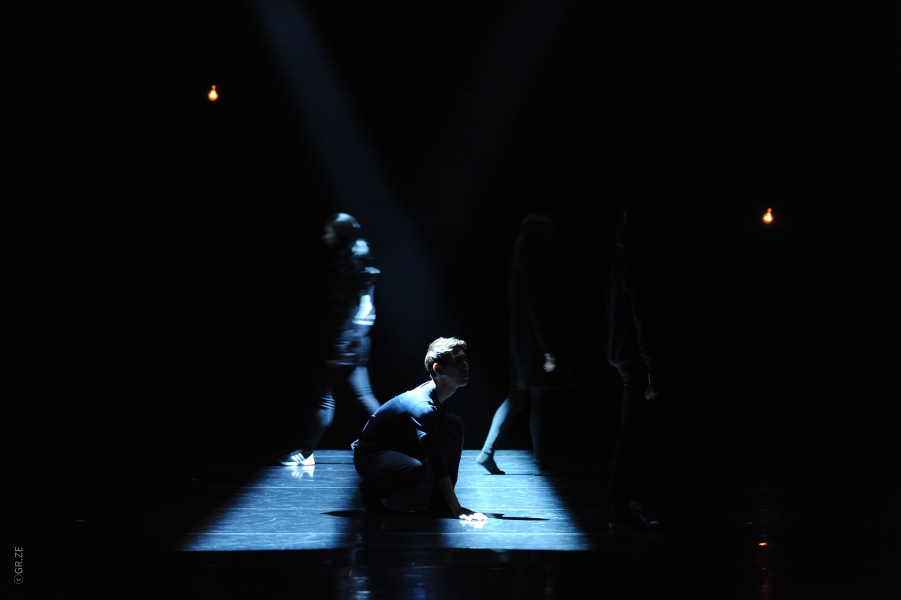Performance Info
Performance Info
About CompanyLed by JEON, Hyuk-jin a contemporary dance choreographer the GROUND ZERO Project group works on dance performances and carries out in-depth collaborations with many diverse genres of arts including dance films, orchestras, photography, video art and contemporary music. Apart from stage performances it is in a constant pursuit of various creative works such as photo exhibitions, art installations, dance films. The group’s unique identity is created by its pictorial approach to contemporary issues and bold mise-en-scène. GROUND ZERO Project is often described as an experimental project group that reconstructs existing patterns.
IntervieweeArt Director Jeon, Hyuk-jin
Interview
Q: A dancer and choreographer by profession, you also pursue diverse creative works such as photography, installation art, and dance film. Tell us about your background.
While working as a dancer, I felt a strong desire to create and express myself. That’s why I founded the GROUND ZERO project in 2008. I believe that all forms of art will someday be united as one and I wanted to try out many different things. I began film work because I loved movies and believed that a unique synergy could be had by combining dance and cinema. My goal is to find a method to express creative works in different forms. You could say that I work in both choreography and film — but, to me, they are the same.
Q: “Agape” is a transposition of the various icons that appear in Middle Age paintings into dance art and shows your profound observations about love. What kind of message did you want to deliver?I wanted to create a story about my deeply personal thoughts and experiences. When I was creating “Agape,” I looked back on my childhood and reflected on how love continues in a parent-child relationship. I was also curious about the circumstances that transform people from loving to selfish individuals. This curiosity expanded into a questioning of whether absolute love can be possible. The work begins with a portrayal of a baby tethered to his mother’s belly. He grows into a toddler who can barely walk. He eventually becomes an adult who cannot adjust to society and ends up hurting others to protect himself. I wanted to show how these little evils eventually turn a man into a monster. But, when the man’s fears reach a climax, he goes running back to his mother and hides in her skirt. The mother envelops her son, covers his face, and fights his fears. I wanted to portray the absolute love of a mother who protects her child until the very end with boldness and courage.
Q: “Extinction” is a story about the countless people who once existed in our lives, as well as the various times and incidents, but continue to vanish from our lives. What kind of questions did you have and hope to resolve through this work?In my previous work, I was researching death when it occurred to me that people who no longer exist in my memory are “dead.” I breathed in the same space as so many people, but, if I can no longer remember them, you could say they’ve become extinct for me. If they’ve been wiped from my memory, are they dead or alive? “Extinction” was my attempt to answer this question. “Extinction” was an exhibition performance staged in collaboration with photographer Oh Joong-seok. I wanted to show the simultaneous process of existing and falling into extinction through photography. The audience in the theater watches me dance, but the image of me dancing inside the photo frame gradually disappears. I wanted to show the process of people in your memory gradually fading away. This dance exhibition is comprised of scenes that exist then disappear from our memories, such first love fading away (“First Love”), breathing every day but not realizing or remembering its importance (“Breath”), fleeting moments of pleasurable self-satisfaction followed by emptiness (“Masturbation”), and photographs taken for a brief moment (“Portrait”).
Q: The themes in your work — such as love, making choices, extinction, and death — are profound and show deep contemplation on your part. As a choreographer, tell us about the methods you use to relay your message, and the creative direction you pursue.From childhood, I loved watching movies. When I create, I feel the influence of movie-making in the way I choose themes and express myself. I use symbolic objects, stage sets, and sound effects in my work. These elements are also used in cinematography, so I often get my themes and inspiration from movies. I remember watching Woody Allen’s romantic film “Manhattan” and being reminded of death and agape. My feelings are sometimes the complete opposite from the typical reaction. I try to look at any object or event from various angles. And, when I choreograph, I choose humanistic subjects. I may deal with a difficult theme, but I try to break it down into workable elements and combine these in the hopes of making them more digestible. In “Agape,” I make tortuous body movements to create meaning about the head sculptures. Because all these movements pile up into layers of meaning, when I finally place my hands on the head, the meaning expands. I don’t present the audience with answers. I leave everything open and add symbolic references so that there’s room for different interpretations. Using lighting effects might have been more effective, but I wanted something real and big to be on the stage. I don’t like two-dimensional things, and yet my work is frequently said to look like a painting. I think this is because I prefer the raw and analog, as opposed to digital effects.
Q: Tell about the CHRYSALIS Project you participated in this year.Just as a chrysalis transforms into a butterfly after being locked up in a cocoon, we can overcome the difficulties of the COVID-19 lockdown. The CHRYSALIS Project is a global performing arts project that fuses classical music, dance, and film that was initiated by conductor Hannah Schneider. It included choreographers, dancers, composers, and filmmaking teams from Korea, the United Kingdom, the United States, Russia, New Zealand, and Burkina Faso. The music was performed by the Oxford Alternative Orchestra. The Korean CHRYSALIS team was composed of choreographer Cha Jin-yeop, two dancers from the Universal Ballet Corps, and me. I was in charge of filming the performance and I tried to present the beauty of classical ballet. This interesting project was positively received by the public and talks are underway for follow-up work.
Q: You film the dances of other companies. As a choreographer, what significance do you find in expanding your work into other forms?We call art forms with strong theatrical factors “theater” and those with strong dance factors “dance.” However, there are dances and movements in theater. To a dancer, an actor’s hand gestures look like a dance. In contrast, when dancers speak dialogue or immerse themselves in a role, actors can get the impression that the dancers are acting. All these factors combine to form a stage show. Currently, there’s a delineation of genres — but, one day, I believe they will all become united in a single piece of performance art. I think film has expanded the stage for artists who usually work in performance halls. Watching a well-made dance film will lure audiences in to see a live dance performance. Film has the advantage of being edited and shot from various angles, which allows the audience to see more detailed expressions. I think artists will now engage in creative works with the possibility of filming in mind. For artists unfamiliar with film, it can be a bridge that connects stage art and cinema art.
Q: What are your plans for the future?Until now, I’ve mainly focused on stage work, but I’d like to do more film work. I hope to do one stage performance, then one film. I have a short dance film production in the works for next year. I recently made a dance film with an actor, which was a good opportunity to reach the public. I wanted to create videos that are art films, yet accessible to and appreciated by the public.
Production Details
Major Productions〈Agape〉
〈Pathless wood〉
〈Perfect death〉
〈Extinction〉
〈‘The CHRYSALIS Project’ Wave of Wave〉
- 2019 Pori Dance Company 30th Anniversary Performance, Finland
- 2016 PDC Dance Festival, Finland
- 2016 Autumn Season of NCPA ‘Heart,’ China
- 2013 Sofia Dance Week, Bulgaria
- 2013 PDC Dance Month Festival, Finland
- 2012 MASDANZA International, Spain
groundzeroproject
ground.zero.project
Production Details
- Director
Jeon, Hyuk jin
Dancer and choreographer Geon Hyauk Jin works across media, including fashion modeling, musical theater, and film. Geon has won numerous dance competitions in Korea, and won prizes in choreography contests at the Yokohama Dance Collection in 2010 and the MASDANZA in 2012.
In 2008, Geon formed the Ground Zero Project, a multidisciplinary artist collective with the goal of promoting collaboration among artists in various fields, bringing together interactive art, a string quintet, installation art and short film. The Ground Zero Project has staged performances in Asia and Europe, seeking to blur the concepts of genre and space associated with contemporary dance. The group is developing a distinctive color as it approaches contemporary topics from various angles, appealing to the senses through original and playful drama and dynamic techniques.








.jpg)
(0).jpg)




 PREV
PREV
 그라운드 제로 프로젝트_소멸ⓒOHJOONGSEOK (1)(0).jpg)


.jpeg)











